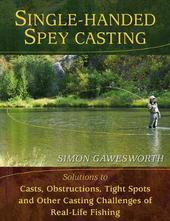
|
Single-Handed Spey Casting: Solutions to Casts, Obstructions, Tight Spots, and Other Casting Challenges of Real-Life Fishing
Hardback
Main Details
| Title |
Single-Handed Spey Casting: Solutions to Casts, Obstructions, Tight Spots, and Other Casting Challenges of Real-Life Fishing
|
| Authors and Contributors |
By (author) Simon Gawesworth
|
| Physical Properties |
| Format:Hardback | | Pages:248 | | Dimensions(mm): Height 280,Width 215 |
|
| Category/Genre | Field sports - fishing, hunting, shooting |
|---|
| ISBN/Barcode |
9780811705592
|
| Classifications | Dewey:799.12 |
|---|
| Audience | |
|---|
| Illustrations |
400 colour photos & 88 illustrations
|
|
Publishing Details |
| Publisher |
Stackpole Books
|
| Imprint |
Stackpole Books
|
| Publication Date |
22 December 2009 |
| Publication Country |
United States
|
Description
How do you cast in tight spots or deal with overhanging branches? Most fly casters use the roll cast, but you can also use the double roll cast, which gives you a little more distance, or the switch cast for even longer casts. Simon Gawesworth shares casts adapted from two-handed spey casting that enable you to fish the challenging spots most anglers skip. Whether you're a small-stream angler casting for tough trout or a saltwater fly fisher wanting to put your fly out beyond the breakers, Simon has refined spey casts for your one-handed rod needs. The single spey allows you to change the direction of the cast and is especially useful on rivers with overhanging trees and bushes. You will be able to target fast-travelling bonefish on flats and cruising trout in lakes. If the wind is blowing downstream with the current, the double spey is your answer. The snake roll also works well when you have to change direction and have obstructions behind; not only that, it is fast and quiet. The snap T is great for casting big flies, weight, and sink tips. For times when you want to keep the fly line low and horizontal, if you are casting under an obstacle, you will want to learn the side cast. The shepherd's crook (often called the positive curve cast or negative curve cast) builds on the side cast. Bending the end of the fly line, you can cast around a rock or directly upstream to a fish that you would otherwise spook by casting over its head. The reach cast bends the end of the fly line nearest you, avoiding obstacles close to you. For fishing sinking lines, the aerial mend puts the mend in the line when you need it, before the line sinks. Gawesworth teaches several options for putting slack in the line. He even has casting solutions for multiple problems, like when you have bushes behind and an overhanging branch in front. You will learn ways to cast a fly to cope with obstructions wherever you find them and whatever water you fish, making it possible for you to fish the waters that frustrate other anglers.
Author Biography
Simon Gawesworth has fished in world championships and has taught spey casting throughout the world. He writes for several fly-fishing magazines and produced the video International Spey Casting. He lives in Ammon, Idaho.
ReviewsExpert spey caster Simon Gawesworth shares casts adapted from two-handed spey casting that enable you to fish the challenging spots most anglers skip.
|